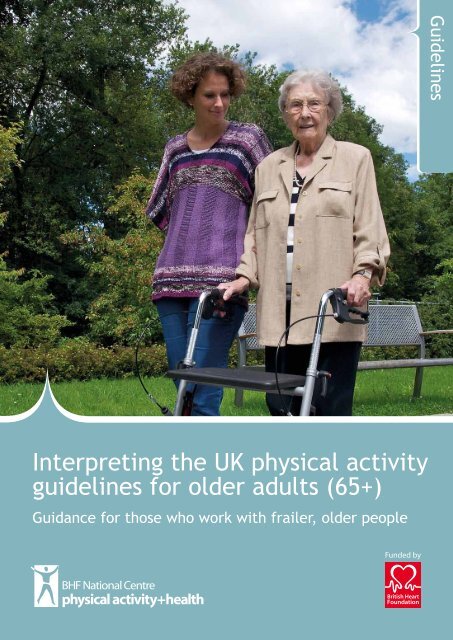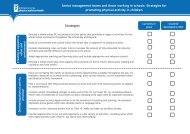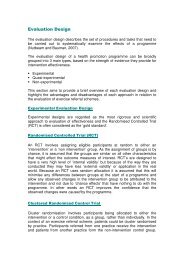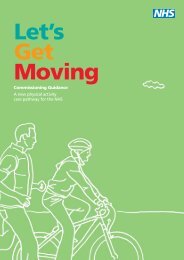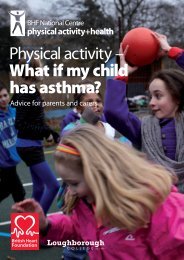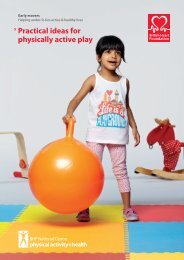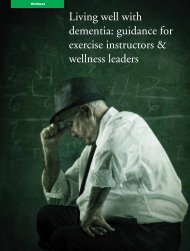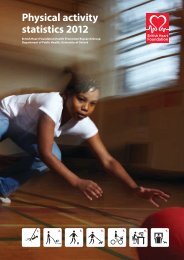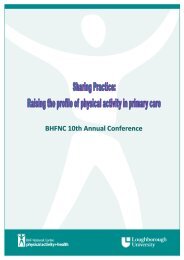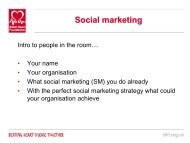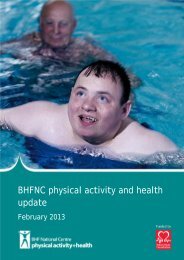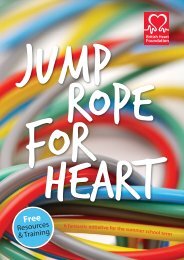Interpreting the physical activity guidelines frailer, older people
Interpreting the physical activity guidelines frailer, older people
Interpreting the physical activity guidelines frailer, older people
Create successful ePaper yourself
Turn your PDF publications into a flip-book with our unique Google optimized e-Paper software.
1<br />
<strong>Interpreting</strong> <strong>the</strong> UK <strong>physical</strong> <strong>activity</strong> <strong>guidelines</strong> for <strong>older</strong> adults (65+)<br />
Guidelines<br />
<strong>Interpreting</strong> <strong>the</strong> UK <strong>physical</strong> <strong>activity</strong><br />
<strong>guidelines</strong> for <strong>older</strong> adults (65+)<br />
Costs of<br />
Physical In<strong>activity</strong><br />
Guidance for those who work with <strong>frailer</strong>, <strong>older</strong> <strong>people</strong><br />
Funded by
2 Physical <strong>activity</strong> for <strong>the</strong> early years<br />
Contents<br />
What are <strong>the</strong> UK <strong>physical</strong> <strong>activity</strong> <strong>guidelines</strong> for <strong>older</strong> adults 1<br />
How do <strong>the</strong> <strong>guidelines</strong> reflect differences among <strong>the</strong> 2<br />
<strong>older</strong> population<br />
How to use <strong>the</strong> <strong>physical</strong> <strong>activity</strong> <strong>guidelines</strong> 3<br />
Why do we need <strong>physical</strong> <strong>activity</strong> <strong>guidelines</strong> for <strong>frailer</strong>, 4<br />
<strong>older</strong> <strong>people</strong><br />
<strong>Interpreting</strong> <strong>the</strong> CMO <strong>guidelines</strong> for those <strong>frailer</strong>, <strong>older</strong> <strong>people</strong> 6<br />
Supplementary information 8<br />
Working towards and achieving <strong>the</strong> <strong>guidelines</strong> 9<br />
Key messages 9<br />
Planning for <strong>the</strong> individual, what activities count 10<br />
Motivating <strong>frailer</strong>, <strong>older</strong> <strong>people</strong> 13<br />
Public advice on <strong>physical</strong> <strong>activity</strong> for <strong>frailer</strong>, <strong>older</strong> <strong>people</strong> 14<br />
Case study 15<br />
Resources to help promote <strong>physical</strong> <strong>activity</strong> and reduce 16<br />
sedentary behaviour amongst <strong>frailer</strong>, <strong>older</strong> <strong>people</strong><br />
Information for stakeh<strong>older</strong>s, including <strong>physical</strong> <strong>activity</strong>, health and social care professionals,<br />
residential setting and care home managers, <strong>activity</strong> co-ordinators, physio<strong>the</strong>rapists and<br />
occupational <strong>the</strong>rapists.<br />
This is one of a series of three documents designed to assist those who work with <strong>frailer</strong> <strong>older</strong><br />
<strong>people</strong> to interpret <strong>the</strong> Chief Medical Officers’ (CMO) <strong>guidelines</strong> on <strong>physical</strong> <strong>activity</strong> for <strong>older</strong><br />
adults (65+).
Guidelines<br />
1<br />
Key term – <strong>older</strong> adults<br />
In this document, <strong>the</strong> term <strong>older</strong> adult is used<br />
to describe <strong>people</strong> over <strong>the</strong> age of 65 years.<br />
Key term – <strong>frailer</strong>, <strong>older</strong> <strong>people</strong><br />
Is used to describe those who are identified as<br />
being frail or have very low <strong>physical</strong> or cognitive<br />
function, perhaps as a result of chronic disease<br />
such as arthritis, dementia or advanced old<br />
age itself. Many <strong>frailer</strong>, <strong>older</strong> <strong>people</strong> will be in<br />
supported living settings and residential care.<br />
Achieving <strong>the</strong> <strong>physical</strong> <strong>activity</strong> <strong>guidelines</strong> for<br />
<strong>older</strong> adults can play an important part in<br />
assisting <strong>frailer</strong>, <strong>older</strong> <strong>people</strong> to maintain <strong>the</strong>ir<br />
health, wellbeing, independence and social<br />
participation in later life.<br />
The UK Chief Medical Officers’<br />
<strong>guidelines</strong> for <strong>older</strong> adults<br />
The introduction of <strong>the</strong> UK <strong>physical</strong> <strong>activity</strong> <strong>guidelines</strong><br />
for <strong>older</strong> adults in 2011 follows <strong>the</strong> lead of o<strong>the</strong>r<br />
international countries. They are based on evidence<br />
from research and provide information on how much<br />
<strong>physical</strong> <strong>activity</strong> is required to achieve health and<br />
o<strong>the</strong>r benefits.<br />
What are <strong>the</strong> UK <strong>physical</strong><br />
<strong>activity</strong> <strong>guidelines</strong> for<br />
<strong>older</strong> adults<br />
1. Older adults who participate in any amount<br />
of <strong>physical</strong> <strong>activity</strong> gain some health benefits,<br />
including maintenance of good <strong>physical</strong> and<br />
cognitive function. Some <strong>physical</strong> <strong>activity</strong> is better<br />
than none, and more <strong>physical</strong> <strong>activity</strong> provides<br />
greater health benefits.<br />
2. Older adults should aim to be active daily. Over a<br />
week, <strong>activity</strong> should add up to at least 150 minutes<br />
(2½ hours) of moderate intensity <strong>activity</strong> in bouts of<br />
10 minutes or more – one way to approach this is to<br />
do 30 minutes on at least 5 days a week.<br />
3. For those who are already regularly active at<br />
moderate intensity, comparable benefits can be<br />
achieved through 75 minutes of vigorous intensity<br />
<strong>activity</strong> spread across <strong>the</strong> week or a combination of<br />
moderate and vigorous <strong>activity</strong>.<br />
4. Older adults should also undertake <strong>physical</strong><br />
<strong>activity</strong> to improve muscle strength on at least<br />
two days a week.<br />
5. Older adults at risk of falls should incorporate<br />
<strong>physical</strong> <strong>activity</strong> to improve balance and<br />
co-ordination on at least two days a week.<br />
6. All <strong>older</strong> adults should minimise <strong>the</strong> amount<br />
of time spent being sedentary (sitting) for<br />
extended periods.<br />
A full copy of <strong>the</strong> Chief Medical Officers’ Report Start<br />
Active, Stay Active (2011) is available to download at<br />
www.bhfactive.org.uk/<strong>guidelines</strong><br />
Making <strong>physical</strong> <strong>activity</strong> a priority
2<br />
<strong>Interpreting</strong> <strong>the</strong> UK <strong>physical</strong> <strong>activity</strong> <strong>guidelines</strong> for <strong>older</strong> adults (65+)<br />
How do <strong>the</strong> <strong>guidelines</strong> reflect<br />
<strong>the</strong> differences among <strong>the</strong><br />
<strong>older</strong> population<br />
These <strong>guidelines</strong> are relevant to all <strong>older</strong> adults,<br />
but it is not appropriate to consider all <strong>older</strong> adults<br />
as a homogeneous population. With an age range<br />
of 40 years or more <strong>the</strong>re is significant diversity,<br />
and chronological age is not always helpful when<br />
describing differences in health, <strong>physical</strong> function<br />
and disease status among <strong>older</strong> adults. Many <strong>people</strong><br />
in <strong>the</strong>ir late 80s do as well as those in <strong>the</strong>ir 60s, yet<br />
some in <strong>the</strong>ir early 70s have a functional status more<br />
expected of a 90 year old.<br />
Regardless of age, ability or previous <strong>activity</strong> patterns,<br />
<strong>the</strong>se <strong>guidelines</strong> can be applied to all <strong>older</strong> adults.<br />
It is recommended though that <strong>the</strong>y are adjusted for<br />
each individual according to <strong>the</strong>ir needs and abilities.<br />
To assist in clarifying how <strong>the</strong> CMO <strong>guidelines</strong> should<br />
be applied, three groups of <strong>older</strong> adults have been<br />
identified, each with differing functional status and<br />
<strong>the</strong>refore different <strong>physical</strong> <strong>activity</strong> needs. They can<br />
be described as:<br />
1. The actives – those who are already active,<br />
ei<strong>the</strong>r through daily walking, an active job and/or<br />
engaging in regular recreational or sporting <strong>activity</strong>.<br />
This group may benefit from increasing <strong>the</strong>ir general<br />
<strong>activity</strong> or introducing an additional <strong>activity</strong> to<br />
improve particular aspects of fitness or function,<br />
as well as sustaining <strong>the</strong>ir current <strong>activity</strong> levels.<br />
2. Those in transition – those whose <strong>physical</strong> function<br />
is declining due to low levels of <strong>activity</strong>, too much<br />
sedentary time, who may have lost muscle strength<br />
and balance, and/or are overweight but o<strong>the</strong>rwise<br />
remain reasonably healthy. National data indicate that<br />
this makes up <strong>the</strong> largest proportion of <strong>older</strong> adults<br />
and that <strong>the</strong>y have a great deal to gain in terms of<br />
reversing loss of function and preventing disease.<br />
3. Frailer, <strong>older</strong> <strong>people</strong> – those who are frail or have<br />
very low <strong>physical</strong> or cognitive function perhaps<br />
as a result of chronic disease such as arthritis,<br />
dementia, or very old age itself. This group may<br />
require a <strong>the</strong>rapeutic approach, eg, falls prevention<br />
programmes, and many well be in residential care.
Guidelines<br />
3<br />
How to use <strong>the</strong> <strong>physical</strong><br />
<strong>activity</strong> <strong>guidelines</strong><br />
The <strong>guidelines</strong> are issued by <strong>the</strong> four Chief Medical<br />
Officers of England, Scotland, Wales and Nor<strong>the</strong>rn<br />
Ireland and draw on global evidence for <strong>the</strong> health<br />
benefits of regular <strong>physical</strong> <strong>activity</strong> throughout <strong>the</strong> life<br />
course. They take <strong>the</strong> form of evidence-based summary<br />
statements and are <strong>the</strong> basis for <strong>the</strong> development of a<br />
population based approach to <strong>physical</strong> <strong>activity</strong>.<br />
These <strong>guidelines</strong> are written for <strong>the</strong> professional<br />
audience who work with <strong>frailer</strong>, <strong>older</strong> <strong>people</strong> and are<br />
not intended to be used as communication messages,<br />
eg, for motivation, promotion and marketing purposes.<br />
They will need to be interpreted differently for direct<br />
communications with <strong>frailer</strong>, <strong>older</strong> <strong>people</strong>. In general,<br />
<strong>the</strong> CMO <strong>physical</strong> <strong>activity</strong> <strong>guidelines</strong> and this advice<br />
should be used to:<br />
• inform <strong>the</strong> professional development and training of<br />
those working with <strong>frailer</strong>, <strong>older</strong> <strong>people</strong><br />
• form <strong>the</strong> basis of any advice given to <strong>frailer</strong>,<br />
<strong>older</strong> <strong>people</strong> within motivational settings, eg, by<br />
<strong>activity</strong> co-ordinators, <strong>physical</strong> <strong>activity</strong> leaders,<br />
physio<strong>the</strong>rapists and occupational <strong>the</strong>rapists,<br />
exercise class instructors and residential and social<br />
care staff<br />
• underpin <strong>the</strong> design and implementation of <strong>physical</strong><br />
<strong>activity</strong> programmes<br />
• provide a focus for national and local campaigns<br />
designed to target <strong>older</strong> adults, once translated into<br />
appropriate messages<br />
• inform educational materials (booklets, leaflets)<br />
and o<strong>the</strong>r forms of written advice and guidance for<br />
<strong>older</strong> adults<br />
• inform <strong>the</strong> marketing and promotion of local<br />
opportunities and programmes for <strong>frailer</strong>,<br />
<strong>older</strong> <strong>people</strong>.<br />
Frailer, <strong>older</strong> <strong>people</strong><br />
Frailty is a state of vulnerability and arises from<br />
multiple factors. Whilst it is a condition brought about<br />
by a combination of old age and disease, <strong>physical</strong><br />
in<strong>activity</strong> is also known to be a significant contributing<br />
factor. Many <strong>frailer</strong>, <strong>older</strong> <strong>people</strong> will have multiple<br />
medical conditions, such as a combination of arthritis,<br />
diabetes, cardiovascular disease and dementia, and<br />
have very little strength and a fear of falls.<br />
Whilst <strong>the</strong> majority of <strong>older</strong> adults have poor levels<br />
of <strong>physical</strong> function and are overweight/obese, this is<br />
not always <strong>the</strong> case in those classified as <strong>frailer</strong>, <strong>older</strong><br />
<strong>people</strong>. Many in this population will be malnourished<br />
and have sarcopenic obesity (insufficient strength to<br />
support <strong>the</strong>ir weight).<br />
Although many <strong>frailer</strong>, <strong>older</strong> <strong>people</strong> live in residential<br />
care and nursing settings, o<strong>the</strong>rs continue to live in<br />
<strong>the</strong>ir own homes. To do so, <strong>the</strong>y are supported by a<br />
range of services which provide assistance with daily<br />
living and help sustain independence.<br />
Making <strong>physical</strong> <strong>activity</strong> a priority
4<br />
<strong>Interpreting</strong> <strong>the</strong> UK <strong>physical</strong> <strong>activity</strong> <strong>guidelines</strong> for <strong>older</strong> adults (65+)<br />
Why do we need <strong>physical</strong><br />
<strong>activity</strong> <strong>guidelines</strong> for <strong>frailer</strong>,<br />
<strong>older</strong> <strong>people</strong><br />
Physical <strong>activity</strong> is important for <strong>frailer</strong>,<br />
<strong>older</strong> <strong>people</strong><br />
Physical <strong>activity</strong> declines and sedentary behaviour<br />
increases with age. Physical function, mobility and <strong>the</strong><br />
ability to perform activities of daily living also declines<br />
with age. There is strong evidence regular <strong>physical</strong><br />
<strong>activity</strong> can assist in reversing <strong>the</strong> age-related decline<br />
in <strong>physical</strong> and psychological function and assist in<br />
maintaining independent living and mobility.<br />
Benefits of <strong>physical</strong> <strong>activity</strong> that can be achieved<br />
in later life include:<br />
• good <strong>physical</strong> and psychological health<br />
and wellbeing<br />
• maintaining cognitive function<br />
• reaching/maintaining a healthy weight<br />
(combined with a reduction in calorie intake<br />
through dietary restriction)<br />
• preserving <strong>physical</strong> function, mobility<br />
and independence<br />
• maintaining social contacts and remaining engaged<br />
with <strong>the</strong> local community<br />
• engaging in opportunities for new learning<br />
and experiences<br />
• maintaining higher levels of energy and vitality to<br />
enjoy life<br />
• improvements in quality and quantity of sleep<br />
• lower levels of anxiety and depression, improved<br />
mood and self esteem.<br />
Among <strong>the</strong> frailest of <strong>older</strong> adults, <strong>physical</strong> <strong>activity</strong><br />
and movement that promote circulation will assist in<br />
reducing <strong>the</strong> complications of immobility including:<br />
• deep vein thrombosis (a blood clot in one of <strong>the</strong><br />
deep veins – usually in <strong>the</strong> calf or thigh)<br />
• gravitational oedema (swelling of <strong>the</strong> feet and<br />
lower legs caused by accumulation of fluid)<br />
• contractures (thickening of <strong>the</strong> joint tissues leading<br />
to deformity)<br />
• pressure sores<br />
• faecal impaction (severe constipation).<br />
One of <strong>the</strong> major risks of daily living associated with<br />
this age group is <strong>the</strong> risk of falls. There is strong<br />
evidence to support <strong>the</strong> benefits of specific, targeted<br />
and progressive exercise programmes to help reduce<br />
this risk.<br />
More detailed information on <strong>the</strong> benefits of <strong>physical</strong><br />
<strong>activity</strong> for <strong>older</strong> <strong>people</strong> is included in <strong>the</strong> BHFNC<br />
<strong>older</strong> adults evidence briefing at<br />
www.bhfactive.org.uk/<strong>older</strong>-adults
Guidelines<br />
5<br />
There is a significant increase in <strong>the</strong> numbers of<br />
<strong>older</strong> <strong>people</strong> reaching advanced old age<br />
Ten million <strong>people</strong> in <strong>the</strong> UK are over 65 years old,<br />
and within this total, <strong>the</strong> number of very old <strong>people</strong><br />
is rapidly growing. In 2012 <strong>the</strong>re were three million<br />
<strong>people</strong> aged more than 80 years. This figure is<br />
expected to almost double by 2030.<br />
Physical <strong>activity</strong> participation declines with age<br />
Participation in <strong>physical</strong> <strong>activity</strong> declines significantly<br />
with age for both sexes. In 2009 in England, only<br />
20% of men and 17% of women between <strong>the</strong> ages<br />
of 65 and 74 achieved <strong>the</strong> Chief Medical Officer’s<br />
recommendation for <strong>physical</strong> <strong>activity</strong> and similar<br />
levels are reported in Nor<strong>the</strong>rn Ireland, Scotland and<br />
Wales. This drops to 9% and 6% of men and women<br />
respectively over <strong>the</strong> age of 75 (1) .<br />
This decline in <strong>activity</strong> with increasing age and fragility<br />
is fur<strong>the</strong>r established as 86% of women and 78% of men<br />
in care homes are classified as inactive. Moreover,<br />
in<strong>activity</strong> levels are even higher in nursing homes, with<br />
90% of residents not having done a continuous walk of<br />
15 minutes or more in <strong>the</strong> past month (3) .<br />
The consequences of in<strong>activity</strong><br />
Functional capacity declines with age and is fur<strong>the</strong>r<br />
accelerated by low levels of <strong>physical</strong> <strong>activity</strong>. Even<br />
among healthy active <strong>people</strong>, strength, endurance,<br />
balance, bone density and flexibility are all lost at<br />
about 10% per decade. Muscle power is lost at an even<br />
faster rate at around 30% per decade. (4)<br />
Key term – <strong>physical</strong> in<strong>activity</strong><br />
Physical in<strong>activity</strong> is described as “doing no or very<br />
little <strong>physical</strong> <strong>activity</strong> at work, home, for transport<br />
or during discretionary time… not reaching <strong>physical</strong><br />
<strong>activity</strong> <strong>guidelines</strong> deemed necessary to benefit<br />
public health.” (2)<br />
Gradually, this loss in <strong>physical</strong> function will impact<br />
upon an <strong>older</strong> adult’s ability to maintain an<br />
independent life and perform activities of daily living<br />
such as getting out of a chair or using <strong>the</strong> stairs. By<br />
<strong>the</strong> age of 75, only 40% of men and 20% of women can<br />
walk for 30 minutes or more without difficulty. (4)<br />
Sedentary behaviour<br />
Sedentary behaviour increases with age and<br />
observational evidence using self-reporting and<br />
accelerometry indicates that sedentary time rises<br />
sharply from age 70 onwards. (6) Fur<strong>the</strong>rmore, many<br />
<strong>older</strong> adults spend ten hours or more each day sitting<br />
or lying down, making <strong>the</strong>m <strong>the</strong> most sedentary<br />
population (9) .<br />
Key term – sedentary behaviour<br />
Sedentary behaviour refers to a group of<br />
behaviours that occur whilst sitting or lying<br />
down and that typically require very low energy<br />
expenditure. (5) The low energy requirements<br />
distinguish sedentary behaviours from o<strong>the</strong>r<br />
behaviours that also occur whilst seated, eg, chairbased<br />
exercise, but which require greater effort<br />
and energy expenditure. Sedentary behaviour is<br />
not defined simply as a lack of <strong>physical</strong> <strong>activity</strong>,<br />
it is a separate behaviour in its own right.<br />
More detailed information on <strong>the</strong> benefits of <strong>physical</strong><br />
<strong>activity</strong> for <strong>older</strong> <strong>people</strong> is included in <strong>the</strong> BHFNC<br />
<strong>older</strong> adults evidence briefing at<br />
www.bhfactive.org.uk/<strong>older</strong>-adults<br />
Making <strong>physical</strong> <strong>activity</strong> a priority
6<br />
<strong>Interpreting</strong> <strong>the</strong> UK <strong>physical</strong> <strong>activity</strong> <strong>guidelines</strong> for <strong>older</strong> adults (65+)<br />
<strong>Interpreting</strong> <strong>the</strong> CMO <strong>guidelines</strong><br />
for <strong>frailer</strong>, <strong>older</strong> <strong>people</strong><br />
These <strong>guidelines</strong> are applicable to all <strong>older</strong> adults,<br />
irrespective of gender, race or socio-economic status.<br />
When interpreting <strong>the</strong> <strong>guidelines</strong>, consideration<br />
should be given to individual <strong>physical</strong> and mental<br />
capabilities, especially when working with <strong>frailer</strong>,<br />
<strong>older</strong> <strong>people</strong>.<br />
This section provides greater detail on each of <strong>the</strong><br />
<strong>guidelines</strong> with <strong>the</strong> purpose of providing professionals<br />
with an understanding of <strong>the</strong>ir relevance and how <strong>the</strong>y<br />
apply to <strong>the</strong>ir work with <strong>frailer</strong>, <strong>older</strong> <strong>people</strong>.<br />
Guideline 1<br />
Older adults who participate in any amount of<br />
<strong>physical</strong> <strong>activity</strong> gain some health benefits, including<br />
maintenance of good <strong>physical</strong> and cognitive function.<br />
Some <strong>physical</strong> <strong>activity</strong> is better than none, and more<br />
<strong>physical</strong> <strong>activity</strong> provides greater health benefits.<br />
Some <strong>physical</strong> <strong>activity</strong> is better than none<br />
• Frailer, <strong>older</strong> <strong>people</strong> engaging in smaller amounts of<br />
<strong>physical</strong> <strong>activity</strong> will gain some benefits relative to<br />
being inactive.<br />
• It is recommended <strong>frailer</strong>, <strong>older</strong> <strong>people</strong> take part in<br />
some <strong>physical</strong> <strong>activity</strong> every day.<br />
Doing more <strong>physical</strong> <strong>activity</strong> provides greater<br />
health benefits<br />
• The dose-response relationship for <strong>physical</strong> <strong>activity</strong><br />
and health indicates ‘more is better’ in terms of <strong>the</strong><br />
health benefits of <strong>physical</strong> <strong>activity</strong>.<br />
It’s never too late to start<br />
• There is good evidence that <strong>the</strong> benefits of <strong>physical</strong><br />
<strong>activity</strong> also apply in later, later life, even to those<br />
who have previously been inactive.<br />
• There is good evidence that <strong>frailer</strong>, <strong>older</strong> <strong>people</strong> in<br />
later life can still obtain increases in <strong>physical</strong> fitness<br />
and <strong>physical</strong> function.<br />
Guideline 2<br />
Older adults should aim to be active daily. Over a<br />
week, <strong>activity</strong> should add up to at least 150 minutes<br />
(2½ hours) of moderate intensity <strong>activity</strong> in bouts of<br />
10 minutes or more – one way to approach this is to<br />
do 30 minutes on at least 5 days a week.<br />
Build up to a total of 150 minutes of <strong>physical</strong><br />
<strong>activity</strong> each week<br />
• For some individuals, particularly <strong>frailer</strong>, <strong>older</strong><br />
<strong>people</strong>, 150 minutes may be daunting and seem<br />
unattainable due to low levels of fitness or<br />
functional capacity. Gradually working towards a<br />
goal of 150 minutes a week is recommended.<br />
• The CMO <strong>guidelines</strong> suggest sessions as short as ten<br />
minutes can provide health benefits. Accumulating<br />
numerous sessions of ten minutes over a period of<br />
time may be a more realistic way for <strong>frailer</strong>, <strong>older</strong><br />
<strong>people</strong> to achieve <strong>the</strong> CMO <strong>guidelines</strong>.<br />
• For <strong>frailer</strong>, <strong>older</strong> <strong>people</strong> with low levels of <strong>activity</strong>,<br />
engaging in a small amount of <strong>activity</strong>, even at a<br />
level below <strong>the</strong> quantity recommended, will provide<br />
some health benefits relative to being totally<br />
inactive and is a good way to begin.<br />
Physical <strong>activity</strong> should be aerobic <strong>activity</strong> of at<br />
least moderate intensity<br />
• The type of <strong>activity</strong> someone needs to do to qualify<br />
as moderate intensity varies from one individual to<br />
ano<strong>the</strong>r. A <strong>frailer</strong>, <strong>older</strong> person with low functional<br />
capacity may only have to walk at a slow pace for<br />
a short time, whereas a very fit athlete may be<br />
able to run quite fast for a long time before<br />
reaching this level.<br />
• In <strong>frailer</strong>, <strong>older</strong> <strong>people</strong> with low functional<br />
capacity, encouraging <strong>the</strong>m to move for longer<br />
(ie, progressing from five to ten minutes) may also<br />
increase <strong>the</strong> intensity (ie, from low to moderate)<br />
as <strong>the</strong> individual will have to work harder to sustain<br />
<strong>the</strong> <strong>activity</strong>.<br />
• Moderate <strong>physical</strong> <strong>activity</strong> will cause <strong>older</strong> adults to<br />
become warmer, brea<strong>the</strong> harder and feel <strong>the</strong>ir heart<br />
beating faster than usual, but <strong>the</strong>y should still be<br />
able to carry on a conversation.
Guidelines<br />
7<br />
• Many <strong>frailer</strong>, <strong>older</strong> <strong>people</strong> may feel daunted by<br />
being asked to raise <strong>the</strong>ir heart and breathing rate<br />
and may interpret this as an onset of a cardiac<br />
event or asthma.<br />
• Education may be required to reassure <strong>the</strong> <strong>frailer</strong>,<br />
<strong>older</strong> person that <strong>the</strong>se are normal responses<br />
to <strong>physical</strong> <strong>activity</strong> and are safe and appropriate<br />
for <strong>the</strong>m.<br />
• In an <strong>activity</strong> like walking, <strong>frailer</strong>, <strong>older</strong> <strong>people</strong><br />
should focus on <strong>the</strong> perception of <strong>the</strong> effort<br />
<strong>the</strong>y need to make ra<strong>the</strong>r than <strong>the</strong>ir speed. On a<br />
perceived effort scale of 0 (no effort) – 10 (major<br />
effort), moderate intensity <strong>physical</strong> <strong>activity</strong> is<br />
usually rated 5–6.<br />
Guideline 3<br />
For those who are already regularly active at<br />
moderate intensity, comparable benefits can be<br />
achieved through 75 minutes of vigorous intensity<br />
<strong>activity</strong> spread across <strong>the</strong> week or a combination of<br />
moderate and vigorous <strong>activity</strong>.<br />
• It is nei<strong>the</strong>r recommended nor likely that <strong>frailer</strong>,<br />
<strong>older</strong> <strong>people</strong> engage in vigorous <strong>physical</strong> <strong>activity</strong>.<br />
Guideline 4<br />
Older adults should also undertake <strong>physical</strong><br />
<strong>activity</strong> to improve muscle strength on at least<br />
two days a week.<br />
• There is strong evidence for <strong>the</strong> additional health<br />
benefits of muscle streng<strong>the</strong>ning activities.<br />
• The strength recommendations are in addition to<br />
<strong>the</strong> 150 minutes a week.<br />
• Strength activities should not be undertaken on<br />
consecutive days to allow <strong>the</strong> muscles to rest and<br />
repair.<br />
• Some everyday activities can be used as strength<br />
activities, as well as participation in a class or<br />
home-based programme.<br />
• Activities that improve strength are those that use<br />
<strong>the</strong> muscles against a resistance or extra weight and<br />
where <strong>the</strong>y are performed slowly and repetitively<br />
(eg, 8–12 times).<br />
• For a <strong>frailer</strong>, <strong>older</strong> adult, body weight or light<br />
resistance will initially have a streng<strong>the</strong>ning effect.<br />
However as strength improves, heavier weights<br />
and slow repetitions will allow <strong>the</strong> training effect<br />
to continue.<br />
• Muscle streng<strong>the</strong>ning activities involving all major<br />
muscle groups (including <strong>the</strong> shoulder girdle,<br />
arms, trunk, legs and muscles that surround <strong>the</strong><br />
ankles) will provide substantial benefits for <strong>frailer</strong>,<br />
<strong>older</strong> <strong>people</strong>.<br />
• Streng<strong>the</strong>ning activities for <strong>frailer</strong>, <strong>older</strong> <strong>people</strong><br />
include using <strong>the</strong> stairs frequently, Tai Chi or dance,<br />
heavy housework or gardening, lifting and carrying,<br />
repetitive slow sit to stands (rising from a chair)<br />
as well as home-based or group classes that<br />
involve strength exercises, eg, with weights or<br />
resistance bands.<br />
• Muscle streng<strong>the</strong>ning activities will make <strong>the</strong><br />
muscles feel more tension than normal, perhaps<br />
‘shake’ and be warmer.<br />
• It is normal and anticipated that <strong>the</strong> day after<br />
streng<strong>the</strong>ning activities are undertaken <strong>the</strong>re will<br />
be mild muscle stiffness, indicating <strong>the</strong> <strong>activity</strong> had<br />
a training effect.<br />
• Education may be required to reassure <strong>the</strong> <strong>older</strong><br />
adult that <strong>the</strong>se normal responses to muscle<br />
streng<strong>the</strong>ning activities are safe and appropriate for<br />
<strong>the</strong>m, and are necessary to improve strength.<br />
Guideline 5<br />
Older adults at risk of falls should incorporate<br />
<strong>physical</strong> <strong>activity</strong> to improve balance and coordination<br />
on at least two days a week.<br />
33% of <strong>older</strong> adults aged 65 fall every year. This<br />
figure increases to 50% at <strong>the</strong> age of 80 and is even<br />
greater among those living in care homes. (7) There<br />
is good evidence that <strong>physical</strong> <strong>activity</strong> programmes<br />
which emphasise balance training, limb co-ordination,<br />
muscle streng<strong>the</strong>ning and are tailored to <strong>the</strong> individual<br />
are safe and effective in reducing <strong>the</strong> risk of falls<br />
among <strong>frailer</strong>, <strong>older</strong> <strong>people</strong>.<br />
Making <strong>physical</strong> <strong>activity</strong> a priority
8<br />
<strong>Interpreting</strong> <strong>the</strong> UK <strong>physical</strong> <strong>activity</strong> <strong>guidelines</strong> for <strong>older</strong> adults (65+)<br />
Guideline 6<br />
All <strong>older</strong> adults should minimise <strong>the</strong> amount of time<br />
spent being sedentary (sitting) for extended periods.<br />
Prolonged periods of sedentary behaviour are an<br />
independent risk factor for poor health. Sedentary<br />
behaviour rises sharply from <strong>the</strong> age of 70 onwards and<br />
can be as high as 80% of <strong>the</strong> day amongst care home<br />
residents. (8)<br />
• Sedentary behaviour refers to any <strong>activity</strong> that<br />
typically occurs whilst seated or lying down and<br />
which requires very low levels of energy expenditure.<br />
• Sedentary behaviour may be reinforced by <strong>activity</strong><br />
restrictions brought about by loss of <strong>physical</strong><br />
function, fear of falling and by <strong>activity</strong> limiting living<br />
environments.<br />
• Breaking up long periods of sedentary behaviour,<br />
even in those who are chair bound, is highly<br />
recommended. Some examples of ways to help do<br />
this are by standing and (assisted) walking around for<br />
a few minutes, slow sit to stands or seated <strong>physical</strong><br />
<strong>activity</strong>.<br />
• The balance recommendations are in addition to<br />
<strong>the</strong> 150 minutes a week.<br />
• Activities that improve balance for <strong>frailer</strong> <strong>older</strong><br />
adults include standing or moving about whilst<br />
standing and fit in one of <strong>the</strong> following categories:<br />
• reduced base of support, eg, standing on one leg<br />
for a while, going up onto tip toes, walking heel<br />
to toe<br />
• movement of <strong>the</strong> centre of mass, eg, dancing,<br />
standing Tai Chi and yoga, bowling, moving in<br />
different directions, most standing exercise<br />
classes and most music to movement classes<br />
• using movements that challenge balance by<br />
reducing <strong>the</strong> amount of upper body support,<br />
ie, switching from holding on to <strong>the</strong>n being<br />
unsupported during <strong>the</strong> <strong>activity</strong>.<br />
Supplementary information<br />
• Some activities, eg, sit to stands, dancing, Tai Chi<br />
and standing exercise to music, will contribute<br />
towards achieving combined aerobic, strength and<br />
balance recommendations.<br />
• When working with <strong>older</strong> adults who have strength<br />
and balance deficits, additional care needs to be<br />
taken when promoting brisk walking because <strong>the</strong>re<br />
can be an increased risk of falls. There is evidence<br />
that in <strong>the</strong>se individuals, combining specific strength<br />
and balance training with a walking programme can<br />
help reduce this risk.<br />
• Whilst chair-based exercise programmes can<br />
contribute towards moderate intensity <strong>physical</strong><br />
<strong>activity</strong>, strength and some static balance<br />
improvements, <strong>the</strong>re is no evidence <strong>the</strong>y<br />
reduce falls.
Guidelines<br />
9<br />
Working towards and achieving<br />
<strong>the</strong> <strong>guidelines</strong><br />
The more you do, <strong>the</strong> greater <strong>the</strong> benefits<br />
There is a clear dose-response relationship between<br />
<strong>physical</strong> <strong>activity</strong> and <strong>the</strong> prevention of diseases such<br />
as coronary heart disease and type 2 diabetes and<br />
greater benefits occur with increased participation.<br />
From a public health perspective, helping <strong>older</strong> adults<br />
to progress from moving, to moving more often, to<br />
moving regularly and frequently will produce <strong>the</strong><br />
greatest reduction in risk. The more a <strong>frailer</strong>, <strong>older</strong><br />
person is able to move (ie, be <strong>physical</strong>ly active), <strong>the</strong><br />
greater <strong>the</strong> improvement in health and <strong>physical</strong> and<br />
psychological function. Additionally, greater <strong>physical</strong><br />
<strong>activity</strong> levels will significantly contribute towards<br />
maintaining independence and successful ageing in<br />
later, later life.<br />
Key messages<br />
The evidence suggests <strong>the</strong> overall volume is <strong>the</strong><br />
key to obtaining <strong>the</strong> beneficial effects of <strong>physical</strong><br />
<strong>activity</strong> ra<strong>the</strong>r than specific types of <strong>activity</strong> or<br />
combinations of frequency and intensity.<br />
This can be achieved by accumulating short<br />
but regular bouts of <strong>physical</strong> <strong>activity</strong> and,<br />
with improved confidence, firstly increasing <strong>the</strong><br />
duration and <strong>the</strong>n <strong>the</strong> intensity as appropriate.<br />
The addition of strength and balance activities will<br />
bring increased benefits related to independence<br />
and mobility.<br />
In this document, when we describe <strong>the</strong> three stages<br />
of moving, moving more often and moving regularly<br />
and frequently, we are referring to <strong>the</strong> progressive<br />
increase in both duration and intensity.<br />
Figure 1 Increasing <strong>physical</strong> <strong>activity</strong> throughout <strong>the</strong> life span<br />
Making <strong>physical</strong> <strong>activity</strong> a priority
10<br />
<strong>Interpreting</strong> <strong>the</strong> UK <strong>physical</strong> <strong>activity</strong> <strong>guidelines</strong> for <strong>older</strong> adults (65+)<br />
Planning for <strong>the</strong> individual,<br />
what activities count<br />
It is difficult to be prescriptive about what activities<br />
are appropriate for <strong>frailer</strong>, <strong>older</strong> <strong>people</strong>. The needs of<br />
<strong>the</strong> individual should be <strong>the</strong> starting point of <strong>physical</strong><br />
<strong>activity</strong> participation. Understanding individual<br />
interests and abilities, previous successful <strong>physical</strong><br />
<strong>activity</strong> experiences, personal beliefs and expectations<br />
of o<strong>the</strong>rs should inform personal choice on suitable<br />
activities. This is in addition to <strong>the</strong> use of an individual<br />
or person centred care plan which includes <strong>the</strong> medical<br />
conditions of <strong>the</strong> individual as well as <strong>the</strong> views of<br />
o<strong>the</strong>r health, <strong>the</strong>rapy and social care professionals.<br />
Sedentary behaviours<br />
As already stated, sedentary behaviours refers<br />
to a group of behaviours that occur whilst sitting<br />
or lying down and that typically require very low<br />
energy expenditure. It is important to recognise that<br />
sedentary behaviours can be present across <strong>the</strong> model<br />
in Figure 1 and regardless of if an individual is on <strong>the</strong><br />
way to meeting <strong>the</strong> <strong>physical</strong> <strong>activity</strong> <strong>guidelines</strong>.<br />
In many cases, even this amount of movement will<br />
require assistance. Some examples of ‘moving’<br />
activities include:<br />
• taking standing breaks from seated activities,<br />
eg, watching TV or reading, using regular slow<br />
sit to stands (rising from a chair)<br />
• increased independence during activities of daily<br />
living, eg, dressing, washing and bathing<br />
• increased (independent) performance of everyday<br />
living tasks, eg, cooking, household activities<br />
• any <strong>physical</strong> <strong>activity</strong> that promotes circulation<br />
• (assisted) walk and talk conversations with<br />
friends and family<br />
• (assisted) or independent walking to meals,<br />
o<strong>the</strong>r activities and outdoors<br />
• active play with <strong>the</strong> (great) grandchildren.<br />
Frailer, <strong>older</strong> <strong>people</strong> tend to spend most of <strong>the</strong>ir<br />
day in sedentary behaviours. It is important to offer<br />
<strong>the</strong>m opportunities and encouragement to break up<br />
<strong>the</strong>se periods of sitting, even if it is just with simple<br />
movements, like standing up from <strong>the</strong>ir chair.<br />
Moving<br />
As <strong>frailer</strong>, <strong>older</strong> <strong>people</strong> spend so much time in<br />
sedentary behaviours, <strong>the</strong> first step is to encourage<br />
<strong>the</strong>m to move. Even <strong>the</strong> frailest and most inactive<br />
individuals can benefit from beginning to move even<br />
at a low intensity. For those with very limited <strong>physical</strong><br />
function, small bouts of movement that promote<br />
circulation, eg, being encouraged to independently<br />
perform activities of daily living, will provide <strong>the</strong><br />
opportunity to build <strong>physical</strong> <strong>activity</strong> into a daily life.
Guidelines<br />
11<br />
Moving regularly and frequently<br />
The final goal is enabling <strong>frailer</strong>, <strong>older</strong> <strong>people</strong> to move,<br />
ie, be <strong>physical</strong>ly active, on a regular basis. While <strong>the</strong>y<br />
may be unable to be active for a long period of time,<br />
short frequent bouts can still bring about considerable<br />
health benefits. Some strategies used to increase<br />
frequency include:<br />
• augmenting weekly group-based activities with<br />
individual take-away activities<br />
• significant o<strong>the</strong>rs using a variety of prompts and<br />
reminders to assist this process<br />
Moving more often<br />
With increased confidence and success, more<br />
<strong>physical</strong> <strong>activity</strong> can be built into individual lives<br />
and <strong>the</strong> routine of a living environment by increasing<br />
opportunity. These might include:<br />
• (assisted) walking with purpose<br />
• moving around <strong>the</strong> living environment<br />
• getting out into <strong>the</strong> fresh air, eg, gardening<br />
• getting started in a new <strong>activity</strong> of choice or group,<br />
eg, dance and movement to music.<br />
For some <strong>frailer</strong>, <strong>older</strong> <strong>people</strong>, encouraging <strong>the</strong>m to<br />
move more often may also provide <strong>the</strong> stimulus to<br />
increase from low to moderate intensity activities.<br />
• adding additional activities to daily and weekly<br />
routines, eg:<br />
• group-based dance and movement, Tai Chi<br />
and games activities, swimming or<br />
water-based activities<br />
• opportunities to visit places of interest in <strong>the</strong><br />
local community, eg, garden centres, shopping<br />
centres, places of worship<br />
• joining a local <strong>activity</strong> group or class.<br />
Including strength and balance<br />
The strength and balance recommendations are in<br />
addition to <strong>the</strong> 150 minutes a week. Strength and<br />
balance activities can be achieved through some<br />
everyday activities as well as participation in a class or<br />
home-based programme of specific exercises. Examples<br />
of strength and/or balance activities include:<br />
• improving wrist/grip strength, eg, squeezing soft<br />
balls and progressing to firmer balls<br />
• improving leg strength, eg, sit to stand from a chair<br />
(increasing repetitions or at a slower pace<br />
to progress)<br />
• use of stairs and steps (including repetition and<br />
changing leading leg)<br />
• strength and balance training groups and falls<br />
prevention classes in <strong>the</strong> local community<br />
• slow heel raises whilst supported to<br />
increase confidence.<br />
Making <strong>physical</strong> <strong>activity</strong> a priority
12<br />
<strong>Interpreting</strong> <strong>the</strong> UK <strong>physical</strong> <strong>activity</strong> <strong>guidelines</strong> for <strong>older</strong> adults (65+)<br />
Maintaining function in later life<br />
For some <strong>frailer</strong>, <strong>older</strong> <strong>people</strong>, measurable<br />
improvements in function in later, later life may<br />
be hard to demonstrate. Consequently, participation<br />
in <strong>physical</strong> <strong>activity</strong> may serve to maintain <strong>physical</strong><br />
and psychological functioning and activities of daily<br />
living. Additionally, it importantly helps sustain a<br />
meaningful quality of life through interaction with<br />
o<strong>the</strong>rs and <strong>the</strong> environment.<br />
Chair-based activities (including exercise)<br />
Whilst chair-based activities are an excellent way of<br />
introducing <strong>physical</strong> <strong>activity</strong> movement and exercise,<br />
<strong>the</strong> very nature of chair-based activities means that<br />
what is achievable is limited. Some <strong>frailer</strong>, <strong>older</strong><br />
<strong>people</strong> will prefer <strong>the</strong> security and stability provided<br />
by <strong>the</strong> chair, while o<strong>the</strong>rs may be restricted to chairbased<br />
activities by <strong>the</strong>ir functional limitations. That<br />
being said, some streng<strong>the</strong>ning activities started<br />
in a chair will allow joints to become more stable,<br />
and a <strong>frailer</strong>, <strong>older</strong> person may eventually be able to<br />
progress to standing work.<br />
To achieve optimal improvements in endurance,<br />
balance, co-ordination and o<strong>the</strong>r functional<br />
movements required in everyday life, it is beneficial<br />
to work towards supported standing activities and<br />
eventually to free standing strength and walking<br />
activities. This process should be aided by an<br />
appropriately qualified and experienced professional.<br />
Group-based activities<br />
In addition to providing opportunities for <strong>physical</strong><br />
<strong>activity</strong>, both seated and standing group activities,<br />
eg, dance and movement, Tai Chi and games, provide<br />
increased motivation through social interaction and<br />
opportunities for learning. However, it is unrealistic<br />
to expect that <strong>the</strong>se activities are provided on a daily<br />
basis. Teachers and group leaders should encourage<br />
and educate participants to continue with activities<br />
included within group sessions in <strong>the</strong>ir own time.<br />
These activities can add to <strong>the</strong> total volume of<br />
<strong>physical</strong> <strong>activity</strong> undertaken throughout <strong>the</strong> week.
Guidelines<br />
13<br />
Motivating <strong>frailer</strong>, <strong>older</strong> <strong>people</strong><br />
Increasing <strong>physical</strong> <strong>activity</strong> among <strong>frailer</strong>, <strong>older</strong> <strong>people</strong><br />
represents a significant challenge. Many may depend<br />
on o<strong>the</strong>rs for basic activities of daily living and have<br />
disabling conditions. Similarly, <strong>frailer</strong>, <strong>older</strong> <strong>people</strong><br />
may have cognitive impairments or be concerned<br />
about falling or over-exertion. Also, patterns of<br />
sedentary behaviour may be well established with no<br />
habitual routine of <strong>physical</strong> <strong>activity</strong>.<br />
Frailer, <strong>older</strong> <strong>people</strong> will be more motivated to be<br />
active when <strong>the</strong>y:<br />
• find a sense of purpose or reason to move, eg,<br />
relevance to <strong>the</strong>ir situation and self-identity<br />
• feel safe and can trust those assisting and<br />
supporting <strong>the</strong>m<br />
• believe that significant o<strong>the</strong>rs, eg, family members,<br />
care givers and professionals, have positive<br />
attitudes towards <strong>the</strong>ir <strong>physical</strong> <strong>activity</strong><br />
• have confidence in <strong>the</strong> skills of <strong>physical</strong> <strong>activity</strong><br />
instructors, teachers and leaders<br />
• are successful and recognise <strong>the</strong>ir own<br />
achievements<br />
• discover opportunities to interact and socialise<br />
with o<strong>the</strong>r <strong>people</strong><br />
• engage with personal interests and enthusiasms.<br />
Appropriate programming and leadership<br />
Programmes in residential and care settings should<br />
be feasible, acceptable to staff and participants, and<br />
be evaluated using relevant outcomes for <strong>physical</strong><br />
function and quality of life. In all settings, those<br />
providing <strong>physical</strong> <strong>activity</strong> programmes should have<br />
adequate training and understanding of <strong>the</strong> specific<br />
needs and differences in <strong>physical</strong> <strong>activity</strong> for <strong>frailer</strong>,<br />
<strong>older</strong> <strong>people</strong>.<br />
Benefits and risk<br />
Evidence suggests <strong>frailer</strong>, <strong>older</strong> <strong>people</strong> are concerned<br />
about over-exertion and causing harm to <strong>the</strong>mselves.<br />
Additionally, during <strong>physical</strong> <strong>activity</strong>, <strong>the</strong> fear and<br />
risk of falls may be fur<strong>the</strong>r exaggerated in <strong>frailer</strong>,<br />
<strong>older</strong> <strong>people</strong>.<br />
The risks associated with taking part in <strong>physical</strong><br />
<strong>activity</strong> at a health promotional level, though, are<br />
minimal for most individuals. Continuing with an<br />
inactive lifestyle presents greater health risks than<br />
gradually increasing <strong>physical</strong> <strong>activity</strong> levels. Those<br />
who are <strong>the</strong> least active have <strong>the</strong> most to gain from<br />
taking part in even small increases of regular <strong>physical</strong><br />
<strong>activity</strong>. If <strong>frailer</strong>, <strong>older</strong> <strong>people</strong> gradually increase <strong>the</strong><br />
volume and/or intensity of <strong>the</strong>ir <strong>physical</strong> <strong>activity</strong>, <strong>the</strong>y<br />
are unlikely to face undue risks.<br />
An individual care plan should indicate <strong>the</strong> extent to<br />
which a <strong>frailer</strong>, <strong>older</strong> person can be encouraged to<br />
move independently, walk or require support and/or<br />
supervision from a professional. When recommending<br />
<strong>physical</strong> <strong>activity</strong> to <strong>frailer</strong>, <strong>older</strong> <strong>people</strong> it is important<br />
to take into consideration any long-term medical<br />
condition <strong>the</strong>y may have and how this influences <strong>the</strong>ir<br />
capacity for <strong>physical</strong> <strong>activity</strong>. A focus and building<br />
upon what an individual can do should be <strong>the</strong> starting<br />
point of any <strong>physical</strong> <strong>activity</strong> programme.<br />
Most importantly, <strong>the</strong> health benefits of <strong>physical</strong><br />
<strong>activity</strong> outweigh <strong>the</strong> risks.<br />
Making <strong>physical</strong> <strong>activity</strong> a priority
14<br />
<strong>Interpreting</strong> <strong>the</strong> UK <strong>physical</strong> <strong>activity</strong> <strong>guidelines</strong> for <strong>older</strong> adults (65+)<br />
Public advice on <strong>physical</strong><br />
<strong>activity</strong> for <strong>frailer</strong>, <strong>older</strong> <strong>people</strong><br />
Top line messages<br />
Moving more often every day<br />
1. Something is better than nothing.<br />
2. Build up your <strong>physical</strong> <strong>activity</strong> gradually.<br />
3. Be sure to add activities that will help<br />
you be strong and steady.<br />
4. Limit and break up <strong>the</strong> amount of time you<br />
spend sitting still.<br />
5. The health benefits of <strong>physical</strong> <strong>activity</strong><br />
outweigh <strong>the</strong> risk.<br />
In providing clear and simple advice for <strong>frailer</strong> <strong>older</strong><br />
<strong>people</strong>, <strong>the</strong>se top line messages summarise <strong>the</strong><br />
important information included in <strong>the</strong> CMO <strong>guidelines</strong><br />
for <strong>physical</strong> <strong>activity</strong> and <strong>older</strong> adults. These messages<br />
may need to be tailored for <strong>the</strong> individual.
Guidelines<br />
15<br />
Case study<br />
This case study is provided to illustrate how it is possible for a <strong>frailer</strong>, <strong>older</strong> person to work towards<br />
achieving <strong>the</strong> CMO <strong>physical</strong> <strong>activity</strong> <strong>guidelines</strong>. In addition to <strong>the</strong> activities suggested it highlights <strong>the</strong><br />
type of support from significant o<strong>the</strong>rs and access to <strong>physical</strong> <strong>activity</strong> enhancing environments and<br />
opportunities that might make this possible.<br />
Rosemary 92 years – a <strong>frailer</strong>, <strong>older</strong> person living in a<br />
residential home<br />
Rosemary is single and lives in a residential home as a result of her<br />
increasing frailty and a bad fall following prolonged spells of dizziness and<br />
confusion. She is able to walk with assistance from a walking frame and<br />
is actively involved in <strong>the</strong> user forum that plans a regular programme of<br />
activities for residents.<br />
Rosemary’s increasing frailty has been highlighted within her individual<br />
care plan, and a visiting physio<strong>the</strong>rapist, who leads a weekly strength and<br />
balance class, has provided her with a small number of muscle streng<strong>the</strong>ning<br />
exercises for her legs and arms. Determined to maintain her independence, Rosemary is motivated to do<br />
<strong>the</strong>se by herself, and <strong>the</strong> staff support her mostly through encouragements to do <strong>the</strong> exercises on a regular<br />
basis. Consequently, Rosemary is becoming more confident about walking unaided but supervised to <strong>the</strong><br />
dining room. The staff also ensure she is able to enjoy regular fresh air by accompanying her on assisted<br />
walks to <strong>the</strong> grounds to enjoy <strong>the</strong> scented garden and sitting by <strong>the</strong> ornamental pond. When <strong>the</strong> wea<strong>the</strong>r is<br />
unpleasant, Rosemary substitutes <strong>the</strong>se visits with a corridor walk to visit o<strong>the</strong>r residents.<br />
Rosemary is an enthusiastic participant in painting and music classes, activities that she is encouraged to<br />
do in her own time, and she always attends sessions provided by visiting speakers. In order to break up <strong>the</strong><br />
long periods that residents spend seated and sometimes asleep, <strong>the</strong> staff and residents have agreed a ‘Get<br />
up and Go’ action plan, that encourages residents to make a move of <strong>the</strong>ir own choice every 90 minutes.<br />
As part of this action plan, a refreshment trolley arrives in <strong>the</strong> lounge at regular intervals and residents are<br />
encouraged, when possible, to stand and make <strong>the</strong>ir own drinks. They are also planning a walking challenge<br />
where residents will collectively accumulate and turn walking steps into miles, equivalent to <strong>the</strong> distance<br />
between <strong>the</strong>ir home and a twinned residential home in <strong>the</strong> USA.<br />
Making <strong>physical</strong> <strong>activity</strong> a priority
16<br />
<strong>Interpreting</strong> <strong>the</strong> UK <strong>physical</strong> <strong>activity</strong> <strong>guidelines</strong> for <strong>older</strong> adults (65+)<br />
Resources to help promote<br />
<strong>physical</strong> <strong>activity</strong> and reduce<br />
sedentary behaviour amongst<br />
<strong>frailer</strong>, <strong>older</strong> <strong>people</strong><br />
Chief Medical Officers Report (2011) Department<br />
of Health<br />
Start Active, Stay Active – For <strong>the</strong> full report on<br />
<strong>physical</strong> <strong>activity</strong> for health which summarises <strong>the</strong><br />
<strong>guidelines</strong>, including for <strong>the</strong> first time, <strong>guidelines</strong><br />
for early years and <strong>older</strong> adults (65+). Available at<br />
www.bhfactive.org.uk/<strong>guidelines</strong><br />
Active for Later Life Resource (2008)<br />
A resource for professionals promoting <strong>physical</strong><br />
<strong>activity</strong> amongst <strong>older</strong> adults, including summaries of<br />
evidence, programme planning, working papers and<br />
links to o<strong>the</strong>r organisations. Available at<br />
www.bhfactive.org.uk/<strong>older</strong>-adults<br />
Occupational <strong>the</strong>rapy interventions and <strong>physical</strong><br />
<strong>activity</strong> interventions to promote <strong>the</strong> mental<br />
wellbeing of <strong>older</strong> <strong>people</strong> in primary care and<br />
residential care NICE public health guidance 16<br />
(2008)<br />
This guidance focuses on <strong>the</strong> role of occupational<br />
<strong>the</strong>rapy interventions and <strong>physical</strong> <strong>activity</strong><br />
interventions in <strong>the</strong> promotion of mental wellbeing<br />
for <strong>older</strong> <strong>people</strong>. The guidance is for professionals<br />
who have a role in promoting <strong>older</strong> <strong>people</strong>’s mental<br />
wellbeing, including <strong>the</strong> public, private, voluntary and<br />
community sectors and carers and family members<br />
who support <strong>older</strong> <strong>people</strong>. Available at<br />
www.nice.org.uk/PH16<br />
Physical <strong>activity</strong> and <strong>older</strong> adults (65+) – evidence<br />
briefing (2012)<br />
A summary of <strong>the</strong> evidence on <strong>physical</strong> <strong>activity</strong> for<br />
<strong>older</strong> adults for commissioners, policy makers and<br />
practitioners. Available at<br />
www.bhfactive.org.uk/<strong>older</strong>-adults<br />
Prevention Package for Older People (2009)<br />
Department for Health<br />
The prevention package raises <strong>the</strong> focus on prevention<br />
as a means of ensuring good health, wellbeing<br />
and independence in later life by promoting and<br />
encouraging uptake of comprehensive health and<br />
social care services for <strong>older</strong> <strong>people</strong>. Available at<br />
www.dh.gov.uk/publications<br />
Staying Strong – Staying Steady (AGE UK) DVD<br />
and booklet<br />
Guidance and resources on strength and balance<br />
exercises for <strong>older</strong> <strong>people</strong>. Available at<br />
www.ageuk.org.uk/exercise-materials<br />
Zest for Life (AGE UK)<br />
Based on learning from <strong>the</strong> Age UK Fit as a Fiddle<br />
programme, a series of three booklets on nutrition,<br />
regular <strong>activity</strong> and improving mental health for <strong>older</strong><br />
<strong>people</strong> in care settings. Available at<br />
www.ageuk.org.uk<br />
Chair based Exercise and Otago Exercise<br />
programme exercise booklets<br />
Resources written for <strong>physical</strong> <strong>activity</strong> and exercise<br />
instructors and leaders on exercises for <strong>frailer</strong>, <strong>older</strong><br />
<strong>people</strong>. Available at www.laterlifetraining.co.uk<br />
Guidelines on Older People and Physical<br />
Activity (2008)<br />
A summary of <strong>the</strong> evidence on programming <strong>physical</strong><br />
<strong>activity</strong> for <strong>older</strong> adults. Available at<br />
www.bhfactive.org.uk/<strong>older</strong>-adults
Guidelines<br />
17<br />
References<br />
1. British Heart Foundation National Centre for Physical<br />
Activity and Health. Physical <strong>activity</strong> for <strong>older</strong> adults<br />
(65 + years) Evidence Briefing. BHF National Centre for<br />
Physical Activity and Health. 2012.<br />
2. Bull FC, Armstrong TP, Dixon T, Ham, S, Neiman A,<br />
Pratt M. Chapter 10 <strong>physical</strong> in<strong>activity</strong>. In: Erzzati M.<br />
Lopz AD, Rogers A, Murray CJL, editors. Comparative<br />
Quantification of Health Risks, Global and Regional<br />
Burden of Disease Attributable to Selected Major<br />
Risk Factors. Volume 1 ed. Switzerland: World Health<br />
Organization; 2004. P. 729-881.<br />
3. Health survey for England 2005: Health of <strong>older</strong><br />
<strong>people</strong>. Leeds: The Information Centre. 2007.<br />
4. Skelton DA, Young A, Walker A, Hoinville E. Physical<br />
Activity in Later Life: Fur<strong>the</strong>r analysis of <strong>the</strong> Allied<br />
Dunbar National Fitness Survey and <strong>the</strong> HEASAH.<br />
London: Health Education Authority. 1999. pp. 40-58.<br />
5. Pate RR, O’Neill JR, Lobelo F, The evolving definition of<br />
“sedentary”. Exerc Sport Sci Rev. 2008 10;36(4): 173-8.<br />
6. Health survey for England 2008. Volume 1: Physical<br />
<strong>activity</strong> and fitness. Leeds: The NHS Information Centre<br />
for Health and Social Care; 2009.<br />
7. Department of Health. Falls and fractures: Effective<br />
interventions in health and social care. London.<br />
Department of Health. 2009.<br />
8. Tinetti ME. Prevention of falls and fall injuries in<br />
elderly persons: a research Agenda. Prev. Med.<br />
1994(23): 756-62.<br />
9. Grant MP, Granat MH, Thow MK, Maclaren WM.<br />
Analyzing free-living <strong>physical</strong> <strong>activity</strong> of <strong>older</strong> adults<br />
in different environments using body-worn <strong>activity</strong><br />
monitors. Journal of Aging and Physical Activity.<br />
2010;18(2):171-84.<br />
Making <strong>physical</strong> <strong>activity</strong> a priority
18<br />
Physical <strong>activity</strong> for <strong>older</strong> adults (65+ years)<br />
Keep up-to-date<br />
Our bi-monthly updates bring <strong>the</strong> latest developments in <strong>physical</strong> <strong>activity</strong> and health straight to your<br />
inbox and feature all <strong>the</strong> latest resources and publications, funding opportunities, conferences, events<br />
and much more.<br />
Sign-up to our database – It’s FREE!<br />
To receive our bi-monthly <strong>physical</strong> <strong>activity</strong> update and information about o<strong>the</strong>r resources like this<br />
evidence briefing subscribe to <strong>the</strong> free BHFNC database at www.bhfactive.org.uk/subscribe-to-database<br />
Follow us on Twitter<br />
You can also keep up-to-date on <strong>the</strong> latest news by following us on Twitter. Follow us on @BHFactive<br />
Got a burning question<br />
Do you have a <strong>physical</strong> <strong>activity</strong> query you need an answer to Our helpline may be able to help. Get in<br />
touch on 01509 226421 or email bhfnc@lboro.ac.uk<br />
Last updated July 2012<br />
T51360/DPS/JULY12<br />
Published by<br />
British Heart Foundation National Centre (BHFNC)<br />
for Physical Activity and Health, Loughborough University<br />
T: 01509 226421 F: 01509 226420<br />
www.bhfactive.org.uk<br />
@BHFactive<br />
The British Heart Foundation is a registered charity in<br />
England and Wales (225971) and Scotland (SC039426).


